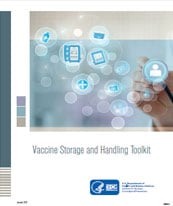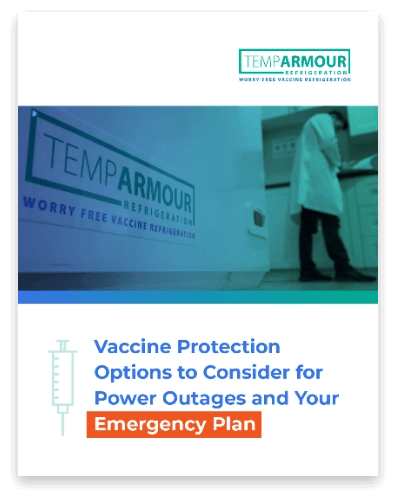 The CDC Vaccine Storage and Handling Toolkit outlines the best practices for vaccine storage and handling based on Advisory Committee on Immunization Practices (ACIP) guidelines, product information from vaccine manufacturers, and scientific studies. Supporting information, recommendations and resources are included in the Toolkit.
The CDC Vaccine Storage and Handling Toolkit outlines the best practices for vaccine storage and handling based on Advisory Committee on Immunization Practices (ACIP) guidelines, product information from vaccine manufacturers, and scientific studies. Supporting information, recommendations and resources are included in the Toolkit.
For the most part, all the information that was in the 2018 version is still in the 2019 Toolkit, and in the same order and sections, with several small changes throughout. The reduction in length of the Vaccine Storage and Handling Toolkit from 81 pages to 48 pages is primarily due to a more compact font, formatting and Table of Contents. The document layout and many of the graphics have also been redesigned.
Notable revisions to the Toolkit include:
New: SECTION SIX: VACCINE TRANSPORT
Vaccine transport information that used to be covered in the “Vaccine Inventory Management” and “Emergency Vaccine Storage and Handling” sections, has been consolidated into the new SECTION SIX: Vaccine Transport.
“Transport, as described in this section, involves the movement of vaccine between providers or other locations over a shorter distance and time frame and is appropriate for events such as an emergency, off-site clinic, or to ensure vaccines that are about to expire can be used rather than wasted.”
A new table in this section “Transport System Recommendations”, clearly shows what type of transport system is recommended based on the reason for transporting vaccines:
Transport System Recommendations:
|
|
Emergency Transport |
Transport for Off-site Clinic, Satellite Facility, or Relocation of Stock |
|
Portable Vaccine Refrigerator or Freezer |
Yes |
Yes |
|
Yes |
Yes |
|
|
Conditioned Water Bottle Transport System |
Yes |
No |
|
Manufacturer’s Original Shipping Container |
Yes (last resort only) |
No |
|
Food / Beverage Coolers |
No |
No |
New Icon: CDC RECOMMENDATION ICON
There are now two icons used throughout the Toolkit to distinguish between CDC Recommendations and Best Practices as defined below:
CDC Recommendation – CDC recommends this as a minimal action to protect your vaccine supply.
CDC Best Practice – CDC recommends best practices as additional actions, practices, and procedures to enhance protection of your vaccine supply.
Moved: VACCINE STORAGE HANDLING PLANS AND SOPS Section
The information that was in the “Vaccine Storage and Handling Plans and Standard Operating Procedures (SOPs)” Section in the 2018 toolkit is now addressed in:
Section Two: Staff and Training
Section Six: Vaccine Transport
Section Seven: Emergency Vaccine Storage and Handling
Resources Section (SOPs Worksheet)
NEW Reference Page: PURPOSE BUILT VACCINE STORAGE UNITS
This section refers to purpose-built vaccine storage units that have been developed specifically for the storage of vaccines. They are often unique in design and can take many forms, from traditional stand-alone type units to dispensing type units. Some of the differences in design of some types of purpose-built units are outlined on this page. Immunization programs determine which purpose-built units meet their VFC program requirements.
OTHER CHANGES:
Although this is not an exhaustive review of every revision to the CDC Toolkit, a few of the updates are highlighted below. We have also included how these sections relate to the TempArmour™ Refrigerators and TempArmour™ Vaccine Carriers:
Note: The TempArmour™ Vaccine Refrigerator is a pharmaceutical-grade, purpose-built refrigerator specifically designed for the effective storage of vaccines. The TempArmour™ Vaccine Carrier is a “Qualified Container and Packout” vaccine transport system.
1/ Under “Temperature Ranges” (Section Three, Page 9):
“factory-set” has been added to:
“Refrigerator or freezer thermostats should be set at the factory-set or midpoint temperature, which will decrease the likelihood of temperature excursions.”
The TempArmour™ Vaccine Refrigerator is a purpose-built refrigerator that arrives with the thermostat setting "factory-set" so that the temperature settles within the optimal range for this refrigerator (3-4.5 °C) to provide the most effective vaccine protection and temperature stability. This lower set point temperature allows the TempArmour™ Refrigerator to maximize its 6 day holdover time during power outages. The lower temperature setting is not a concern for the TempArmour™ refrigerator as its design and technology eliminates the common issues of freezing, cold spots, and temperature spikes.
2/ Water bottle placement in refrigerators (Section Three, Page 13):
“Water bottles are not recommended for use with certain pharmaceutical-grade and purpose-built units. For such units, follow the manufacturer’s guidance.”
No need to add water bottles to the TempArmour™ Vaccine Refrigerator as effective thermal storage is already integrated into the refrigerator to provide exceptional temperature stability.
3/ Non-functioning Units (Emergency Vaccine Storage and Handling, Page 25):
This section has been updated to address how vaccines should be managed in refrigerators and freezers that have stop operating.
“Vaccines may remain inside a nonfunctioning unit as long as appropriate temperatures are maintained. Monitor your DDL to determine when additional action should be taken.”
As TempArmour™ customers know, the TempArmour™ Vaccine Refrigerator is designed to maintain its temperature for up to six days during a power outage, if accidentally unplugged, or for any other reason its operation is disrupted. In fact the TempArmour™ Refrigerator has proven to be an effective alternative to backup power.
4/ Under “Vaccine Transport” (Section Six, Page 21):
This section clarifies what types of soft-sided containers are and aren’t acceptable for vaccine transport:
“Soft-sided containers specifically engineered for vaccine transport are acceptable. Do not use commercially available soft-sided food or beverage coolers because most are poorly insulated and likely to be affected by room or outdoor temperatures.”
The TempArmour™ Vaccine Carrier is an example of a “Qualified Container and Packout” that is specifically engineered for vaccine transport.
DOWNLOAD THE 2019 VACCINE STORAGE AND HANDLING TOOKIT HERE.
Find out more about the 2019 CDC Vaccine Storage and Handling Toolkit and other available resources on the CDC website:
https://www.cdc.gov/vaccines/hcp/storage-handling/

